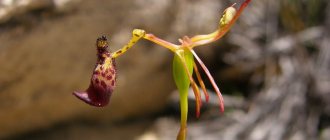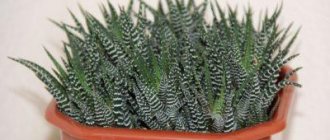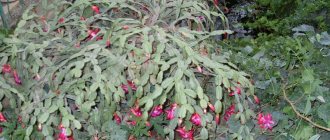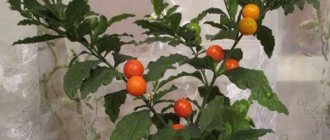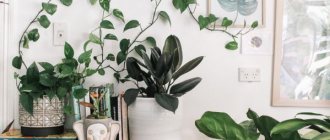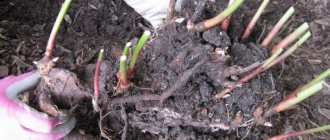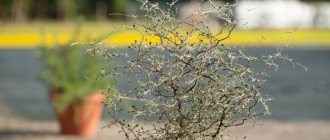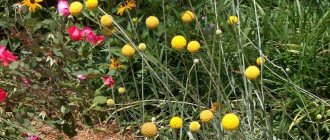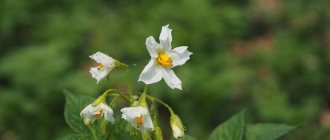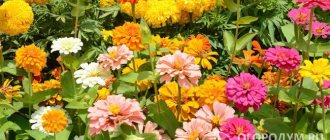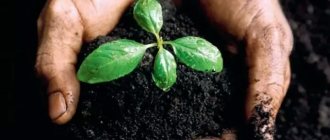The varieties of plants adapted for home conditions are determined by the temperature in the room. Often, ignorance of the characteristics of a particular flower leads to failure in its cultivation. Depending on the temperature in the room, ornamental plants are divided into three categories:
- Cold-resistant plants - from 8 to 14 degrees.
- Moderately heat-loving plants - from 14 to 17 degrees.
- Heat-loving plants - from 18 to 20 degrees.
Heat-loving plants will be discussed in more detail. Let's start with the fact that for the successful growth and development of such plants, the temperature in the room must be uniform, without sudden changes, so they should not be placed close to heating devices and open windows. Not only the upper parts of plants, but also their roots can suffer from temperature changes. Because of this, the soil temperature also needs to be carefully monitored. Let's look at specific examples of heat-loving plants.
Aphelandra
This plant is native to North and South America. There are more than 100 species of aphelandra. As a rule, it is low-growing, no more than 25 cm in height, has succulent stems, leaves are bright green with obvious white stripes. At the end of summer, during flowering, spike-shaped flowers similar to cones appear. After flowering is completed, the buds must be removed, otherwise the plant begins to form seeds that will ripen by winter. Aphelandra is a very capricious plant, and growing it at home will require a lot of effort. Such as selecting the right soil, enriched with minerals, introducing various complementary foods, sufficiently bright lighting, but without direct sunlight. Therefore, in the summer it is necessary to create shade for it, and in the winter, additionally install fluorescent lamps. Without this, the plant will lose its healthy appearance and flowering may be disrupted.
Peppers
Pepper is a tropical perennial plant that can grow and bear fruit for several years in a row. Small peppers are easier to bring home, but you can give any pepper a chance. Peppers love slightly dry soil, poor in nutrition, but bright light is necessary for flowering and fruiting. Watch out for aphids and fungus gnats.
Photo: Shutterstock
Coleus
Coleus has more than 150 varieties. It reaches a height of 80 cm. It is distinguished by its bright colors and ease of care. The leaves of the plant resemble nettles and are green, red and burgundy. Coleus tolerates sunlight well, but in the dry season you need to create shade for it, otherwise the plant will lose its color and begin to turn pale. The plant does not require special care. It is enough to water it with warm water and make sure that the soil is not dry, and feed it with liquid fertilizers containing potassium 2 times a week. In winter, feeding can be done once a month.
Peperomia
This plant is just gaining popularity in Russia and is therefore little known. The main advantage of the flower is its small size and ease of care. So far, about 50 types of peperomia are known. The height of the plant is from 35 to 50 cm, the color of the leaves is very diverse, from light green to dark emerald, sometimes silver or golden. The leaves are round in shape with a short petiole and smooth to the touch. The flowers of the plant have the shape of long tails covered with balls.
Peperomia is known for its medicinal properties and the presence of one or more plants in the house is an excellent prevention against colds. Flower growers also suggest that it has a beneficial effect on the digestive tract.
The conditions for keeping the flower do not change depending on the time of year, it is indifferent to humidity, only young plants under 3 years of age are replanted. For irrigation, you must use heated, settled water with the addition of citric acid. To feed the flower, you can use any liquid mineral complex.
What type of home flowers should you prefer?
Indoor plants can be classified according to different criteria: characteristics of reproduction and flowering, life expectancy, flowering time, type of stem and rhizome.
It is generally accepted to distinguish 8 main types of indoor flowers:
- Beautifully flowering plants delight the eye with magnificent inflorescences. These are azalea, anthurium, begonia, gerbera, rose, pelargonium, phalaenopsis, cyclamen, etc. They differ in flowering time (from a week to several months), life period (one year or more). They require special care, while delighting with regular flowering.
- Decorative deciduous specimens are the largest group, distinguished by the structure, shape of leaves, bushes, and their varied colors. There are bush-like and tree-like creatures with oval, linear, dissected, toothed leaves, as well as hanging stems. This group includes ardisia, dieffenbachia, cypress, ficus, boxwood, myrtle, schefflera, ivy, tradescantia, etc.
- Bromeliad plants are distinguished by hard, spiny leaves that form a rosette, in the center of which small flowers often form. The beauty of this species lies in the leaves located around the inflorescences and having different colors. These include Billbergia, Guzmania, Cryptanthus, and Aechmea.
- Cacti and succulents are a group of unpretentious specimens. They are distinguished by their compactness, fleshy, juicy stems. Cacti are covered with spines with light fluff. The species is represented by aloe, kalanchoe, crassula, hoya, sansevieria, etc.
- Ferns have spreading light green graceful leaves. They reproduce by spores, division and buds, but are not capable of flowering. They prefer partial shade and do not require careful care. Aadiantum, nephrolepis, polypodium and other varieties belong to this species.
- Bulbous plants are flowers with a bulb-shaped underground stem that collects nutrients necessary for nutrition. Does not tolerate damage or waterlogging. They have beautiful blooms and are great for creating compositions. These include hippeastrum, hyacinth, lily, eucharius, etc.
- Palm trees are inhabitants of the tropics, perfectly adapted to our climatic conditions. They have endurance, love light, and can grow over 2 meters. Coconut, date palms, rapis, and chamedorea trees are well placed in spacious rooms.
- Fruit and berry plants now grow well at home. To bear fruit, they require a lot of lighting, regular fertilizer, and warm air. These are avocado, lemon, coffee tree, tangerine.
True flower lovers prefer to have at least one representative of each group in their home greenhouse. When choosing a houseplant, you need to take into account all the characteristics: appearance, size, color scheme, and most importantly - the conditions of maintenance.
Saintpaulia
Simply put - violet. Blooms all year round. The flower has many shades - white, pink, purple, red. The shape of the leaves is elongated, the leaves themselves are fleshy. The main condition for proper cultivation is proper lighting, and this means diffused light for 11 hours a day. It is also necessary to eliminate drafts, they have an adverse effect on Saintpaulia flowers. You need to water the plant so that water does not fall on the leaves, as a result they quickly begin to rot; to avoid this, pre-settled water should be poured into the tray of the pot.
Geranium (pelargonium)
Flower growers often leave geraniums to winter indoors. The plant can go dormant for the winter, and if you have a bright window facing south, the geranium can bloom. The easiest way for a geranium to survive winter is if it grows outside in a pot, since its roots will not be damaged. Bring the geranium indoors before frost and prune the plant a little. Water the plant when the soil is dry and it will bloom.
Photo: Pixabay
Sankhetia
Of all the varieties of Sanchetia, only one type of plant is grown at home - Sanchetia nobilis. It reaches a height of 1 meter, the leaves are large, bright green with golden veins. With proper care, flowering is possible. The flowers are tubular, spike-like, yellow or orange. In winter, it is necessary to provide additional lighting, otherwise the leaves will lose their color and begin to fall off. It is necessary to water the sanchetia abundantly and often, not forgetting to spray the leaves, and this must be done with warm and always boiled water. Fertilize the flower with mineral and organic fertilizers containing nitrogen.
Begonia
Indoor begonia pleases the eye of gardeners all year round and has many varieties. There are both small bushes 5 cm in height and large ones up to 3 meters. There are more than 1000 species of begonia. It mainly has carved leaves and voluminous flowers of various shades.
For the harmonious development of a flower, you need to choose the right place in the apartment, where there will be enough light for it, since the speed of growth will depend on the illumination. And this place must be permanent so that changes in light and temperature cannot destroy the plant. In summer, begonia should be watered generously with settled, clean water, but it is not recommended to spray the leaves, as this may cause unsightly spots to appear on them. In winter, watering should be reduced and the pot carefully insulated.
To prevent begonia from looking exhausted, it requires fertilizer. These are complex mineral mixtures created specifically for this plant. Feeding is carried out in spring and summer 1 or 2 times a week. But if the flower does not stop blooming even in winter, complementary feeding must be continued.
Dieffenbachia
Dieffenbachia is native to South America. This is an evergreen, showy plant with elegant, large leaves. It is very popular among flower growers. But it has one drawback - the milky sap of the plant is poisonous, can cause swelling of the larynx and tongue, and if it gets into the eyes, it can cause blindness. Therefore, it is not recommended to acquire this plant if there are animals and children in the house. Caring for Dieffenbachia begins with choosing a place where there will be good lighting, but without direct sunlight, as the leaves can get burned. Due to lack of light, the leaves of the plant become small and lose color. Watering the flower should be regular, using settled melt or rain water, or boiled water. It is also necessary to spray the leaves daily and clean them of dust. In order for the Dieffenbachia to be straight and the leaves on it to be evenly spaced, it must be illuminated from above and constantly turned in different directions towards the light. Since the plant has large volumes, it constantly needs nutrients in the form of mineral fertilizers. You need to feed them in spring or early autumn once every 10 days. Fertilizers should be high in nitrogen.
Background
If your aquarium is installed against a wall, then you can use a decorative background. The easiest way to do this is with the help of various films and decorations sold in pet stores. It’s more interesting to do it yourself, using branches, leaves or decorative panels. The design of the aquarium looks most natural if the background is decorated with thin tall plants or moss, planted in a dense wall.
Anthurium
Anthurium is native to the subtropical forests of Central America, so maintaining it at home will require a lot of effort. The flower has more than 900 species. The plant has large, heart-shaped leaves with bright veins. Flower colors come in red, pink, green and yellow shades. Anthuriums are extremely demanding on lighting; it must be bright, but without sunlight; in winter, the room must be equipped with fluorescent lamps; without proper lighting, the plant will wither. The plant also needs high humidity, it is necessary to water it 3, 4 times a week, as well as spray the leaves, it is advisable to provide the room with a humidifier. The flower also needs regular replanting and soil fertilization.
Beloperone
Beloperone has more than 60 varieties. The plant is a shrub with bare and slightly pubescent leaves of a round shape, red, orange or yellow. It blooms all year round. Grows in warm, ventilated and well-lit areas. The flower should not be watered frequently; the soil should not be waterlogged. Drying should also be avoided, otherwise the plant will lose all its flowers and leaves. The plant requires constant, weekly feeding due to year-round flowering. Young beloperones must be replanted annually, and bone meal must be added to the soil so that the plant takes root better.
Blekhnum
Blechnum is a type of fern with bright green, leathery leaves and a short rhizome. Loves high humidity; if it is not possible to create humidity in the room, then it is necessary to create it inside the pot. It is necessary to water the blechnum daily, but do not allow stagnation of water so that the plant does not die. The plant needs to be replanted once a year in soil containing peat. Blekhnum is afraid of sunlight, so it should be placed in the bathroom or kitchen, next to the sink, most importantly away from the window. For many heat-loving plants, a number of general rules can be distinguished:
- In summer, it is best to stay in the fresh air, mainly during daylight hours, while avoiding drafts.
- Direct sunlight should not touch the plants.
- In the cold season, it is necessary to remove the plant from the window and provide it with good lighting.
By following them, plants receive proper care, and their owners can enjoy the beauty of their pets all year round.
Cold-resistant plants
All wild plants of the temperate zone are cold-resistant and frost-resistant to varying degrees. Many of them prefer to be in the shade on a hot afternoon.
Traditional garden crops for Russia are cold-resistant: carrots, onions, beets, peas, horseradish, sorrel and others. Carrots, garlic, horseradish preserve the root system under the snow. Parsley leaves remain fresh under the snow until severe frosts, and new leaves grow from the carrot-like root in the spring.
Rice. 2. Parsley.
